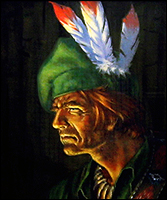St. Francis Raid
| St Francis Raid | |||||||
|---|---|---|---|---|---|---|---|
| Part of the French and Indian War | |||||||
 Inauthentic depiction of Robert Rogers; there are no known likenesses of Rogers taken from life |
|||||||
|
|||||||
| Belligerents | |||||||
|
Abenaki |
|
||||||
| Commanders and leaders | |||||||
| unknown (village defense) Jean-Daniel Dumas (pursuit) |
Robert Rogers | ||||||
| Strength | |||||||
| unknown | 142 | ||||||
| Casualties and losses | |||||||
| 30-200 killed 5-20 captured |
Assault: 1 killed and 7 wounded Retreat: 40 killed and 10 captured |
||||||
The St. Francis Raid was an attack in the French and Indian War by Robert Rogers on St. Francis, near the southern shore of the Saint Lawrence River in what was then the French province of Canada, on October 4, 1759. Rogers and about 140 men entered the village, which was reportedly occupied primarily by women, children, and the elderly, early that morning, slaughtered many of the inhabitants where they lay, shot down many who attempted to flee, and then burned the village. Rogers reported killing as many as 300 people, while French reports placed the number closer to thirty, mainly women and children. One of Rogers' men was killed, and seven were wounded.
Rogers and his men endured significant hardships to reach the village from the British base at Fort Crown Point in present-day New York, and even more hardship afterwards. Chased by the French and vengeful Indians, and short on rations, Rogers and his men returned to Crown Point via the Connecticut River valley. Missteps in caching food stores for the expedition's use led to starvation, and some of Rogers' men were reportedly driven to cannibalism in order to survive. About one third of the raid's participants did not return.
British colonial reports of the raid were unapologetic, as St. Francis had long been a place from which the natives raided colonial settlements as far south as Massachusetts, and Rogers reported a large number of English scalps decorating the main village buildings.
The 1759 summer campaign season in the French and Indian War was a resounding success for the forces of Great Britain. Fort Ticonderoga was captured in July, as was Fort Niagara, and Quebec was under siege. General Jeffery Amherst, the victor at Ticonderoga, had little news of the situation before Quebec, and he required accurate intelligence before deciding whether a move of his army along Lake Champlain was warranted. To that end he sent one party of rangers out on August 7 to reach General James Wolfe near Quebec by traveling up the Kennebec River, a long and roundabout route that took the party nearly one month to complete. Although this party successfully traveled the route in both directions, the time taken meant that their news was effectively useless to Amherst due to the lateness of the season.
...
Wikipedia
